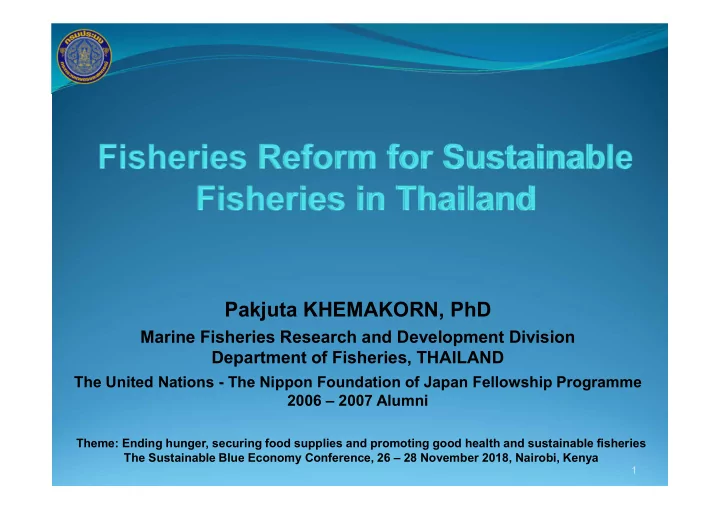

Pakjuta KHEMAKORN, PhD Marine Fisheries Research and Development Division Department of Fisheries, THAILAND The United Nations - The Nippon Foundation of Japan Fellowship Programme 2006 – 2007 Alumni Theme: Ending hunger, securing food supplies and promoting good health and sustainable fisheries The Sustainable Blue Economy Conference, 26 – 28 November 2018, Nairobi, Kenya 1
Introduction The Blue Economy supports the same outcome as the Green Economy, namely “ improved human well-being and social equity, while significantly reducing environmental risks and ecological scarcities” Food and nutrition security is one of the fundamentals, involving food availabilities in terms of food production and food stocks. Sustainable fisheries , mariculture and aquaculture significantly contribute to the achievement of this goal. Sustainable Fisheries in Thailand context, focusing on Capture Fisheries (important ocean-based industries) 2
Thailand Thailand is located in South East Asia. Total land area: 513,115 km 2 Including 77 provinces Coastal area: consist of 23 provinces (both the Gulf of Thailand and Andaman Sea) Coastline: 2,614.40 km (the Gulf of Thailand 1,874.80 km & the Andaman Sea 739.60 km) EEZ: 420,280 km 2 Gulf of Thailand: 304,000 km 2 (86 m max. in depth) Andaman Sea: 116,280 km 2 (3,777 m max. in depth) 3
Fisheries Product Values (at Current Market Prices) of Thailand (THB Million) (%) 140,000 3 120,000 2.5 100,000 2 80,000 1.5 60,000 1 40,000 0.5 20,000 Fisheries Product Values % Fisheries Product Values in GDP 0 0 In 2014 , equalling THB 129,666 million ( USD 3,970 million ) or 1.1 per cent of Thailand GDP 4
• Marine fisheries rapidly developed due to: - High-efficiency fishing gears, methods and technologies adopted - Incentives of world fisheries markets • Reached 2.83 million tonnes in 1995 , but suddenly dropped to 1.64 million tonnes in 2008 (mainly because Thai fleets have not been allowed in Indonesian waters.) 5
Status of Marine Fisheries Resources (CPUE) The Gulf of Thailand Year 1961 (99 trawlers) CPUE 297.80 kg/hr Year 2017 (3,048 trawlers / 8,906 total commercial vessels) CPUE 21.99 kg/hr (7.4% of original CPUE) CPUE (kg/hr) of DOF research vessels conducting trawl surveys in the Gulf of Thailand from 1961 to 2017 The Andaman Sea Year 1966 CPUE 410.00 kg/hr Year 2017 (677 trawlers / 2,007 total commercial vessels) CPUE 71.80 kg/hr (17.5% of original CPUE) Depleted stocks CPUE (kg/hr) of DOF research vessels conducting trawl surveys in the Andaman Sea from 1966 to 2017 6
Main causes Open access fisheries Overfishing Overcapacity IUU fishing To address such issues Limited access fisheries Capacity reduction Combating IUU fishing Effective fisheries management and arrangements Thus… Robust Fisheries Reform in Thailand since 2015 7
Policy Framework and Legislation Before 2015 Fisheries Act B.E. 2490 (1947) National legal framework not fulfill obligations under international standards (e.g., UNCLOS) Not effectively facilitate fisheries management measures and arrangements Commencing in 2015 and going onwards Royal Ordinance on Fisheries B.E. 2558 (2015): current fundamental fisheries legal framework Royal Ordinance on Fisheries (No. 2) B.E. 2560 (2017) For more controls on transhipment vessels and supporting vessels, strengthened enforcement of administrative sanctions and other issues that need cooperation across government agencies 8
Royal Ordinance on Fisheries B.E. 2558 (2015) , based on objectives: • Achieve good governance in the management and conservation of aquatic resources and the fisheries sector • Protect special interests of artisanal fisheries and local fisheries communities • Fulfil Thailand’s international obligations on the conservation and management of aquatic resources • Provide effective means for preventing, deterring and eliminating IUU fishing • Use the best scientific evidence to achieve long-term economic, social and environmental sustainability, with the ecosystem based and precautionary approaches, to ensure MSY level of fisheries resources • Prevent and eliminate overfishing and overcapacity • Implement systematic measures • Cooperate with other States, private agencies, and international organisations • Ensure legal working conditions and welfare of workers • Ensure effective MCS activities • Implement the effective traceability system • Impose proportional and deterrent administrative and criminal sanctions 9
Policy Framework and Legislation (cont.) Marine Fisheries Management Plan of Thailand 2015-2019 (FMP 2015-2019), adopted in 2015 Now drafting Marine Fisheries Management Plan of Thailand 2019-2023 (FMP 2019-2023) Royal Ordinance on Thai Vessels B.E. 2561 (2018), enacted in 2018 o Effective management on fishing vessels (licensing & controls) o Closer cooperation between Department of Fisheries and Marine Department 10
Current Fisheries Management and Arrangements Fisheries Management Measures Fishing effort controls: annual catch limit, input controls (TAE, fishing day scheme) Gear restrictions (e.g., mesh size, length of nets) Seasonal closures Ban fishing gears (e.g., push nets) Co-management (for artisanal fisheries, e.g., crab banks) Comprehensive MCS System Before 2015, no effective legal framework Based on the RO Fisheries 2015, comprehensive MCS system and necessary arrangements developed and implemented under the coordination of the Command Centre to Combat Illegal Fishing (CCIF) 11
12
Thailand Maritime Enforcement Coordinating Centre (Thai-MECC): focal point 13
(Forward Inspection Point) 14
Traceability System Before 2015, no effective legal framework so no comprehensive traceability system. Inadequacy of controls on Thai-flagged fishing vessels Insufficiency of cooperation among relevant agencies (domestic, internal) No information system or electronic tracking infrastructure implemented After the RO Fisheries 2015 enacted: Establishment of required legal framework Accession to the Agreement on Port State Measures Establishment of Processing Statement System (PPS), Thai Flagged Catch Certification System (TF) Establishment of cooperation among concerned agencies Fully operational traceability system implemented since 2017 15
Control on Fish and Fisheries Product Importation in Thailand Fish and Fisheries Product Importation Truck and Truck and Air cargo Air cargo Vessel Vessel Car Car Carrier Carrier Fishing Fishing Container Container vessel vessel vessel vessel PSM + Import control Import control 16
Resources and fleet management o Establishment of Fisheries Improvement Projects (FIPs) covering fishing areas in Thai waters by 2021 o Promotion of community-based management Legal framework Monitoring control and surveillance (MCS) Traceability system Fishing labours Collaboration with 10,000 fishing vessels and communities to remove marine litter: 350 tonnes by 2019 17
18
Recommend
More recommend